 Comments and corrections welcome.
Comments and corrections welcome.

 Russia maintains one of the largest and most powerful submarine fleets on the planet. This article summarizes current capabilities and main types.
Russia maintains one of the largest and most powerful submarine fleets on the planet. This article summarizes current capabilities and main types.
Original artwork - CLICK for high resolution:
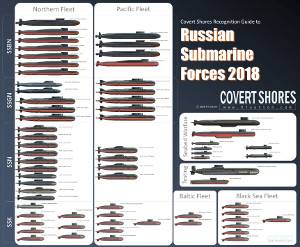
Nuclear submarines, including those tasked with nuclear deterrence, are based exclusively in the Northern and Pacific fleets, while the Baltic Fleet and Black Sea Fleet operate a handful of conventional attack submarines each. The Caspian Flotilla does not currently operate any submarines.
Nuclear Deterrence
There are almost always Russian ballistic missile submarines at sea, from both the Northern and Pacific fleets (ref. Analysis). This represents a return toward the Continuous At-Sea Deterrence (CASD) of the Cold War whereby Russian missile submarines are constantly on watch, ready to retaliate with a nuclear ‘second strike’ in the event of an attack.
Russia is committed to the complete modernization of the SSBN (nuclear powered ballistic missile submarine) fleet, with the final six Project.0955A Borei-A (DOLGORUKIY Class) boats recently ordered. All Borei Class boats are planned to enter service by 2027. This will bring the Borei Class fleet up to 14 boats (3 x Borei Class and 11 x Borei-A Class), completely replacing the last of the DELTA-III and DELTA-IV boats.

Russia is also moving forward with planned operation of the massive Poseidon Intercontinental Nuclear-Powered Nuclear-Armed Autonomous Torpedo. This multi-purpose weapon spans both the strategic deterrent and tactical nuclear domains, and can be thought of as an exceptionally long range torpedo with a nuclear warhead which can target coastal cities, and reportedly moving targets.

Poseidon will not replace submarine launched ballistic missiles and should be viewed as a diversification of the nuclear deterrence rather than a complete shift in capabilities; the SSBNs will still form the backbone of the deterrence. Two submarines are already slated for the weapon, the multi-purpose Project 09852 Belgorod and the purpose-built Project 09851 Khabarovsk. Further deployment is likely to be on the as-yet unnamed Project 09853 Class being developed by Rubin design bureau.
The iconic Project.941 TYPHOON Class, which were the world’s largest submarines, have been retired from active service after the propellant on their massive R-39 (SS-N-20 STURGEON) ballistic missiles expired. A single boat, Dmitriy Donskoy is based in the Northern Fleet and used for trials and photo opportunities:
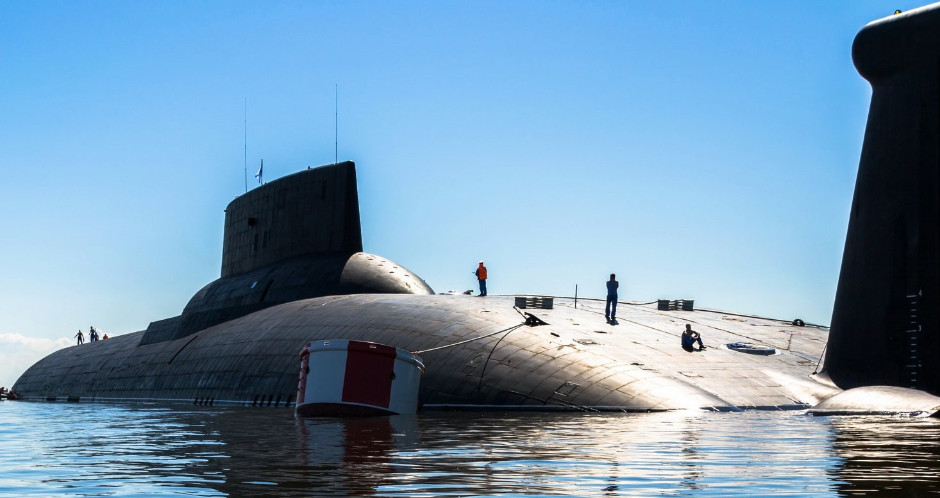
TYPHOON Class SSBN Dmitriy Donskoy
Get The essential guide to World Submarines
This Covert Shores Recognition Guide Covers over 80 classes of submarines including all types currently in service with World Navies.Check it out on Amazon
Cruise Missile Submarines (SSGN)
Traditionally Russia’s fleet of dedicated cruise missile submarines has been largely focused on anti-ship missions, particularly as a direct counter to NATO carrier battle groups. Increasingly the focus is shifting toward land-attack capabilities however.
The Project 885 Yasen Class is widely regarded as one of the most potent nuclear-powered submarines in service. It some respects it is analogous to the US Navy’s Seawolf Class SSNs and it borrows some design features from US Navy boats, notably a spherical bow sonar and related flank torpedo tubes. It adds a vertical launch system (VLS) behind the sail however, resulting in the SSGN categorization (instead of SSN).

Yasen Class SSGN
After a prolonged development period the second boat, 561 Kazan was launched in 2017 to a modified form. Kazan is slightly shorter, with the reduction coming from removing frames in multiple compartments. It is likely that the primary reason is to reduce unit cost. A further five boats are under construction.
The Yasen Class boats’ VLS can carry both the Kalibr-PL land-attack cruise missile and larger P-800 Oniks dual purpose anti-ship / land-attack missile. The VLS on the first boat could carry five Kalibr or three Oniks, while slightly smaller system on subsequent boats can carry four of either.
Eight of the Cold War era OSCAR-II class SSGNs are still in service, armed with twenty four of the massive P-700 Granit (SS-N-19 SHIPWRECK) anti-ship cruise missiles. There have been reports that some of these will be modified to carry Kalibr and Onkis missiles instead but no boats have yet been modified.
Nuclear-Powered Attack Submarines (SSN)
The most modern boats in service are nine AKULA class boats, the last of which was commissioned in 1999. Known for their relative stealth, strong build and deep diving, these are still formidable boats but are a generation behind the latest US and UK designs. They are complemented by four more expensive but slightly older SIERRA Class boats and one remaining VICTOR-III Class boat.
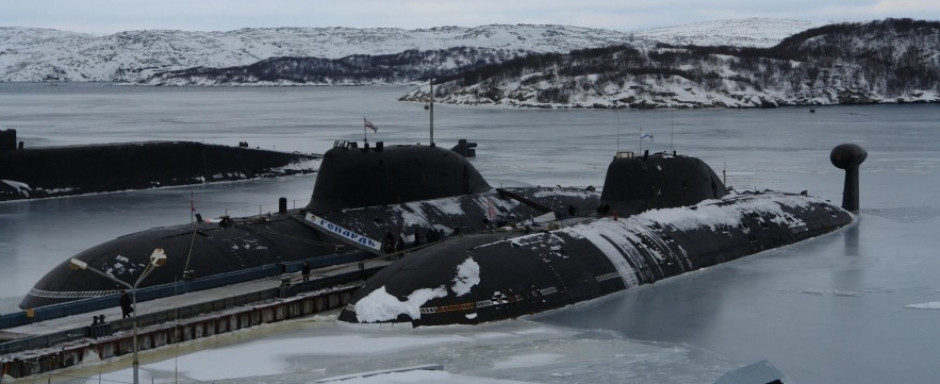
Two AKULA Class SSNs

Since the 1980s SSNs have had a secondary land-attack cruise missile role armed with the SS-N-21 SAMPSON. This system was originally developed in the 1980s as a tactical nuclear but converted to conventional strike after the INF Treaty (Intermediate-Range Nuclear Forces Treaty). The weapon can be carried by AKULA and SIERRA class boats but has been superseded by the more modern Kalibr-PL land-attack cruise missile. While there have been reports of modernization plans for both the SIERRA and AKULA Classes, it is unclear whether any are currently able to carry Kalibr.
Work is underway on a next generation Husky Class attack submarine which will likely replace the older SIERRA and AKULA class boats as well as complement the more expensive Yasen Class SSGNs by carrying more land-attack cruise missiles.
Seabed Warfare Submarines
Russia’s large fleet of Special Mission submarines rivals many Navy’s entire submarine fleet and evidences Russia’s massive investment in Seabed Warfare, especially in the Arctic region. They are based at Olenya Guba (Deer Bay) in the Arctic Circle and operated by 29 Squadron of the Russian Navy on behalf of the Main Directorate of Deep-Sea Research - GUGI (Military Unit 40056).
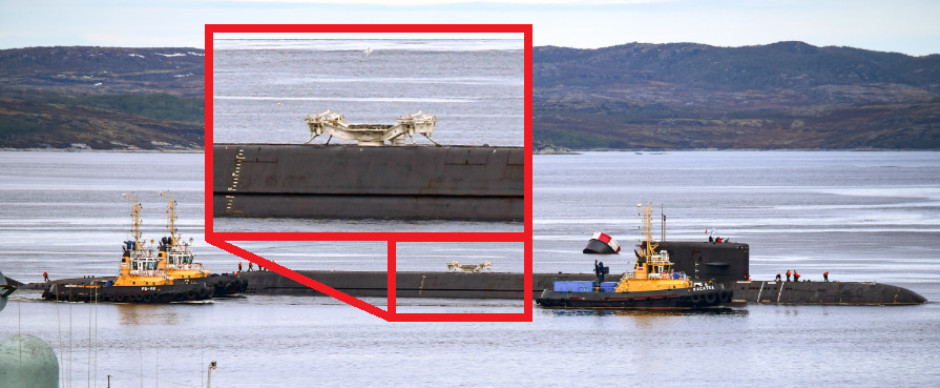
Project 09787 DELTA-IV STRETCH Host Submarine BS-64 Podmoskovye with external payload cradle highlighted. This allows a Project 18270 BESTER rescue submersible (DSRV – Deep Sea Rescue Vehicle) to dock. The DSRV can be used for 'ocean engineering' as well as rescue.
Currently, two very large host submarines based on stretched DELTA-III/IV Class ballistic missile submarines transport smaller 'Deep Sea Stations' (AGS) to their targets. The smaller submarines are carried in special recesses under the keel of the Host Submarine beneath where the missile tubes originally were. The nuclear-powered Deep Sea Stations are able to dive to depths of between 1,000 meters and 3,000 meters, in order to conduct operations on communications cables or other devices on the seabed. Two older UNIFORM Class Deep Sea Stations (AGS) are designed to operate independently of the host submarines.

A new Host Submarine, the even larger Project 09852 Belgorod will join the fleet in the next few years, replacing the Project.09786 BS-136 "Orenburg" (DELTA-III STRETCH).
Conventional Attack Submarines (SS / SSK)
Unlike the US, UK and France, Russia maintains a large fleet of conventional diesel-electric submarines (SS / SSK). These operate in littoral combat and anti-shipping roles, and have also been used for political Show of Force missions launching Kalibr cruise missiles against targets in Syria. Only the newer boats can carry Kalibr and their capacity is limited compared to larger SSGs and SSNs.
Plans to modernize the fleet with the latest Project 677 Lada class have stalled with only one boat in service. The Lada Class was expected to feature Air Independent Power (AIP) but progress has been slow and the lead boat does not yet have this capability. Two further Lada Class boats are planned.

Lada Class SS. These boats are designed to be cheaper than the KILO class and are unusual among Russian designs for being single-hulled instead of double-hulled.
The backbone of the conventional submarine fleet remains the KILO Class, in both the original Project 877 (16 boats) and newer Project 636 Improved-KILO (6 boats) types. An further 6 Improved-KILO are under construction for the pacific fleet where they should replace first generation KILOs.

Unmanned Vehicles (UUV / AUV)
Russia has been slow to develop in-house autonomous underwater vehicles (AUVs), importing civilian and dual use types. To date the most well-known indigenous development has been the Harpsichord family of mid-sized AUVs but several ambitious programs are underway which could shift the balance.
Major large AUV programs:
a) 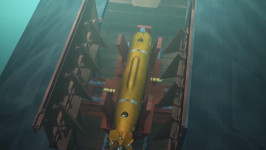 b)
b) 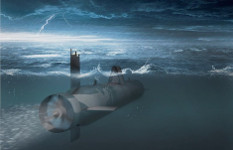 c)
c) 
a) The Hapsichord-2P-2M (Клавесин-2Р-ПМ) designed for carriage by large special mission host submarines such as the Belgorod.
b) The Surrogat (Суррогат) long range autonomous decoy which will be launched by large submarines and used to help break through NATO anti-submarine defenses.
c) The Cephalopod (Цефалопод) family of Armed AUVs designed by Rubin. Images depicting a relatively large bow sonar and two lightweight torpedoes imply an anti-submarine role. Variants or sub-projects include Cefalopod-PZM (Цефалопод-ПЗМ), Cephalopod-ISU (Цефалопод-ИСУ), Cefalopod-MT (Цефалопод-МТ), Cephalopod-MTM (Цефалопод-МТM) and Cephalopod-MR (Цефалопод-МР)

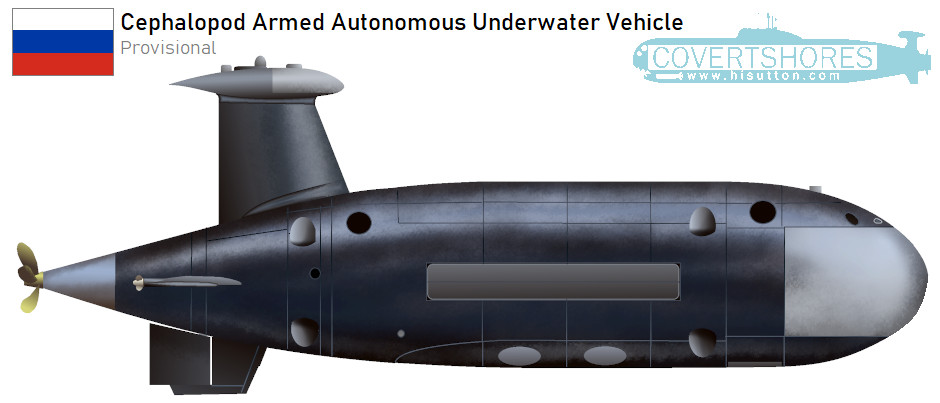
The ultimate book of Special Forces subs Covert Shores 2nd Edition is the ONLY world history of naval Special Forces, their missions and their specialist vehicles. SEALs, SBS, COMSUBIN, Sh-13, Spetsnaz, Kampfschwimmers, Commando Hubert, 4RR and many more.
Check it out on Amazon
Related articles (Full index of popular Covert Shores articles)

 Poseidon Intercontinental Nuclear-Powered Nuclear-Armed Autonomous Torpedo
Poseidon Intercontinental Nuclear-Powered Nuclear-Armed Autonomous Torpedo

 Project 955A 'BOREI-A' Ballistic Missile Submarine. w/Cutaway
Project 955A 'BOREI-A' Ballistic Missile Submarine. w/Cutaway

 Project 705 'ALFA' class attack submarine. w/Cutaway
Project 705 'ALFA' class attack submarine. w/Cutaway

 USS Jimmy Carter (SSN-23) Special Mission submarine
USS Jimmy Carter (SSN-23) Special Mission submarine

 HUSKY Class future attack submarine
HUSKY Class future attack submarine

 BS-64 Podmoskovye Special Mission (spy) Host Submarine
BS-64 Podmoskovye Special Mission (spy) Host Submarine

 Project 09852 Belgorod Special Mission submarine (spy sub). w/Cutaway
Project 09852 Belgorod Special Mission submarine (spy sub). w/Cutaway

 Harpsichord AUV
Harpsichord AUV

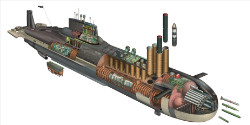 TYPHOON Class SSBN. w/Cutaway
TYPHOON Class SSBN. w/Cutaway




 +
+ 



 Nuclear Missile submarines
Nuclear Missile submarines















 World survey of AIP submarines
World survey of AIP submarines

 P.09851 KHABAROVSK and KANYON (Status-6)
P.09851 KHABAROVSK and KANYON (Status-6)

 SIERRA-I Class SSN
SIERRA-I Class SSN

 Nerpa anti-diver UUV
Nerpa anti-diver UUV

 SIERRA-II Class SSN
SIERRA-II Class SSN

 Russian Losharik spy sub
Russian Losharik spy sub

 Russian Seismic Survey sub
Russian Seismic Survey sub

 Project 1910 UNIFORM Class deep diving spy sub
Project 1910 UNIFORM Class deep diving spy sub

 Russian X-RAY Class spy sub
Russian X-RAY Class spy sub

 Russian Sarov experimental sub
Russian Sarov experimental sub


